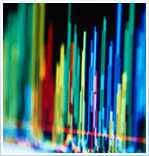
Our PDM group is focused on development of innovative therapies through an improved understanding of targets, pathways and modeling for preclinical efficacy, and discrete toxicity. We will pursue collaborations to enhance physiological relevance of pharmacological endpoints, biomarkers/biomeasures and metabolomics, systems pharmacology/PKPD, quantitative bioanalytics, prediction of transporter-mediated disposition, tissue targeting.
We are interested in establishing alliances to develop and access:
-
Translational research – large and small molecule efforts
- Translational modeling and simulation approaches, systems pharmacology/PK-PD, integrated with quantitative biomeasures; deeper knowledge of targets and pathways; and increased confidence in target and drug selection
- Systems models of specific areas of toxicity, e.g., cardiovascular toxicity and application of PKPD to safety biomarker technologies increasing confidence in safety
- Understanding and de-risking the influence of hepatic and renal uptake and clearance on toxicology in these organs – focus on disorders of bile production and bile acid transport
-
Quantitative Bioanalytics, Biomarkers, Biomeasures, and Immunogenicity (ADA) Assays
- Novel LC-MS/MS large molecule bioanalysis and automation techniques
- Stable isotope labelled pulse chase studies with LC-MS/MS for measurement of target turnover
- Flow cytometry, cellular imaging techniques (Amnis) for biomarkers and biomeasures , and highly multiparametric single cell analysis using mass cytometry (CyTOF)
- Development of a universal platform for cell-based neutralizing antibody assays
- Biocomparability: identification of critical attributes influencing PK and disposition
- Targeted and untargeted metabolomics and fluxomics
- Biotherapeutics bioanalytical capabilities across various modalities
- Next-generation of advanced intelligent high-throughput automation platforms for bioanalysis
-
Alternative methodologies to analytical reagent generation, characterization and modification
- Methods & reagents for high specificity ligand binding and affinity capture LCMS
-
Disposition of Antibody-Drug Conjugates
- Cellular and systemic fate of the conjugate and components
- Quantification and prediction of pharmacokinetics
-
Biodistribution of large molecules (drug and target) at whole organ and cellular level
- Catabolism of large molecules (drug and target) at tissue level
-
Disposition and delivery of therapies – large and small molecule efforts
- Novel commercially viable delivery technologies (oral and non-oral)
- Predictive tools and technologies targeting oral absorption and disposition of peptides
-
Targeting, prediction and modeling of transporter-mediated disposition and DDIs – small molecules
- Quantitation and scaling of transporters for input into physiological PK models of tissue penetration and clearance
- Determination of intracellular unbound concentrations of transported drugs
- Prediction and quantification of human transport mediated (e.g., biliary) clearance
- Novel approaches to achieving selective tissue distribution
-
Immunogenicity prediction – large molecules
- In silico immune epitope prediction
- In vitro drug-specific immune response (e.g., PBL stimulation; whole protein & epitope mapping; DC-T cell assays, Bcell response assays)
- Ex vivo immune response and immune tolerance biomarkers
- Models for predicting immunogenicity impact of product and treatment-related risk factors
- ADA Clinical relevance predictors to include: ADA affinity measures and prediction of adverse events, e.g., infusion reactions
-
Physiologically relevant in vitro assays
- Methods for expanding cell numbers or stabilizing phenotypes of directly isolated primary cells (particularly from patients)
- Robust, reliable in vitro differentiation protocols from human pluripotent stem cells for difficult to obtain cell types
- Non-natural amino acid substitutions in target proteins to create novel screening readouts
- Advances in human genome editing technologies for greater speed and efficiency and reduction of off-target effects
- Advances in High Content Analysis cell based assays
- Endogenous gene reporter and genetically encoded biosensor models in human primary cells and stem cells
- Detection of tagged-protein at physiologically relevant concentrations in human cell based assays
- Visualization of drug interaction with targeted- protein within the cellular environment
- Quantification of cellular environment changes by biosensors
- Advances in 3D culture systems and high content analysis for metabolism, safety, distribution and pharmacology
- Visualization of drug interaction with targeted-protein within the cellular environment
- Quantification of cellular environment changes by biosensors
- Advances in high content analysis in 3D culture system
- Novel expression approaches for functional expression of difficult gene families e.g., solute transporters
-
In vitro Phenotypic Screening:
- o Novel deconvolution advances for in vitro phenotypic screening
- o Prediction of in vitro cellular phenotypic changes due to patient-derived single point mutation and genetic defects
- o Quantification of electro-physiologic measurement in plate cell based assays
- o Advances in single cell mass cytometry technology for phenotypic screening
-
Optimizing Human ADME Properties and PK Prediction Capabilities
- Novel technologies to enhance SAR for ADME properties utilizing chemical library, high- throughput in vitro assays coupled to LC-MS detection and computational models
- Full complement of drug metabolism assays, including biotransformation and induction capabilities
- Ability to conduct a suite of nonclinical studies to develop robust human PK prediction for routine and less common elimination pathways (AO, UGT, GST etc.,)
- Integration in vitro and in silico PK data and mechanisms into PB-PK models to predict human plasma-time profiles for small and large molecules
- Selection and deselection of monoclonal antibody drug candidates based on PK properties that are predictive of human PK by using a characterized human FcRn transgenic mouse model and allometric scaling
- o Prediction of routine and complex DDI involving CYPs and transporters